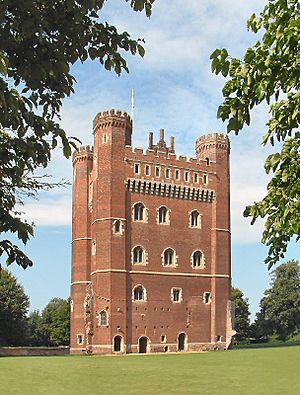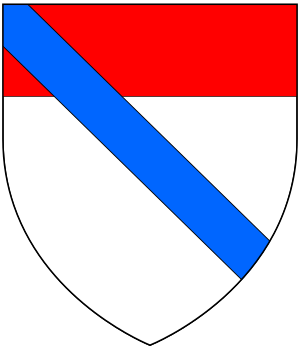Ralph Cromwell, 3rd Baron Cromwell facts for kids
Quick facts for kids
The Lord Cromwell
|
|
|---|---|
| Treasurer of England | |
| In office 1433–1443 |
|
| Monarch | Henry VI |
| Preceded by | The Lord Scrope of Masham |
| Succeeded by | The Lord Sudeley |
| Chamberlain of the Household | |
| In office 1450–1455 |
|
| Monarch | Henry VI |
| Preceded by | The Lord Saye and Sele |
| Succeeded by | Thomas Stanley |
| In office 1425–1432 |
|
| Monarch | Henry VI |
| Preceded by | The Lord FitzHugh |
| Succeeded by | The Lord Bardolf |
| Personal details | |
| Born |
Ralph de Cromwell
c. 1393 Lambley, Nottinghamshire |
| Died | 4 January 1456 South Wingfield, Derbyshire, England |
| Resting place | Tattershall, Lincolnshire, England |
| Nationality | English |
| Occupation | Politician and diplomat |
Ralph de Cromwell, 3rd Baron Cromwell (born around 1393 – died 4 January 1456) was an important English politician and diplomat. He was a trusted advisor to the king from 1422. He held key roles like Lord High Treasurer (in charge of the country's money) from 1433 to 1443. He was also the Lord Chamberlain of the Household (a senior royal official) twice, from 1425 to 1432 and again from 1450 to 1455. These roles were during the time of King Henry VI.
Ralph de Cromwell also owned and improved several large properties. One of his most famous projects was Tattershall Castle in Lincolnshire.
Contents
Who Was Ralph de Cromwell?
Ralph de Cromwell was the son of Ralph de Cromwell, 2nd Baron Cromwell. His mother was Joan Grey. She was the daughter of a famous writer named Thomas Grey.
Early Life and Military Service
When he was young, Ralph de Cromwell worked for Thomas, Duke of Clarence. He joined the Duke's army in France in 1412.
Cromwell fought for King Henry V at the famous Battle of Agincourt in 1415. He continued to fight in France throughout Henry V's reign. In 1417, he was with Henry V when the city of Caen was captured. He then served as a leader in the Duke of Clarence's army. In May 1420, he helped King Henry V negotiate the Treaty of Troyes. This treaty was an agreement between England and France.
His Role in Politics
Ralph de Cromwell earned the trust of King Henry V. He also gained the confidence of Henry's brother, John, Duke of Bedford. When Henry VI was too young to rule, Cromwell became a very important member of the royal council.
He was first called to Parliament on 29 September 1422. In November of that year, he was chosen to be part of the council that would rule while the king was a child. Soon after, he became the Lord Chamberlain of the Household. In 1426, he was sent to help settle a disagreement between Humphrey, Duke of Gloucester and Cardinal Beaufort.
Cromwell usually supported Cardinal Beaufort. In 1432, when Beaufort was away, Duke Humphrey removed Beaufort's friends from their jobs. This is how Cromwell lost his position as Chamberlain. He complained to the House of Lords that he had been fired without a good reason. He showed letters from the Duke of Bedford praising his work in France. He was told that he left his job with a good reputation, but he did not get his old job back right away.
In the summer of 1433, the Duke of Bedford returned to England. During his visit, Cromwell and other officials who had been removed were given their jobs back. Cromwell was made Lord High Treasurer. This meant he was in charge of all the country's money. During his time as Treasurer, the war in France cost a lot. The king's debts grew, even though Cromwell tried to control spending. In July 1443, Cromwell left his role as Treasurer. This might have been because William de la Pole, Duke of Suffolk was becoming more powerful. Cromwell then became the Chamberlain of the Exchequer, a role he held until 1455.
Cromwell became important again in 1449. He had a disagreement with William Tailboys, a local landowner who was a supporter of the Duke of Suffolk. In November 1449, Tailboys attacked Cromwell. Cromwell started legal action against Tailboys, but Suffolk tried to stop it. Cromwell then took action against Suffolk. Tailboys was sent to the Tower of London and found guilty in 1450. Suffolk was also accused of wrongdoing and was later killed. Cromwell was made Chamberlain of the Household again in the same year.
After Suffolk's fall, many disagreements broke out among powerful families. Cromwell had enemies from both the House of York and the House of Lancaster. He seemed to support the Yorkist side. He also had a big disagreement over land with Henry Holland, Duke of Exeter.
Building and Landholdings

Ralph de Cromwell paid for many building projects during his life. These included properties in Collyweston in Northamptonshire and South Wingfield in Derbyshire. In his will, he asked for the church in Lambley to be rebuilt. His parents and grandparents were buried there.
He inherited Tattershall Castle in Lincolnshire. This castle became his main home. At Tattershall, he paid for the building of several structures. These included the Grand Tower at the castle, the college, the Holy Trinity church, and two almshouses (homes for the poor). The National Trust, which now owns the castle, calls the Grand Tower "a masterpiece of early English brickwork." They also say it is "one of the three most important surviving mid-15th-century brick castles in England."
Cromwell also bought a manor in Wymondham in Norfolk. This place still has his name today.
Marriage, Death, and Burial
Before 1433, Ralph de Cromwell married Margaret Deincourt (who died in 1454). She was the daughter of John Deincourt, 12th Baron Deincourt. They did not have any children.
Cromwell died on 4 January 1456 at South Wingfield in Derbyshire. He was buried at the church in Tattershall in Lincolnshire.
Who Inherited His Titles?
Since Ralph de Cromwell had no children, his title was passed down to his two nieces. They were the daughters of his only sister, Maud.
- Maud Stanhope (died 1497) was the older niece. She eventually became the only heir. She married three times:
* First to Robert Willoughby, 6th Baron Willoughby de Eresby. * Second to Sir Thomas Neville. * Third to Sir Gervase Clifton.
- Joan Stanhope (died 1490) was the younger niece. She married twice:
* First to Sir Humphrey Bourchier. He was called to Parliament as Lord Cromwell or Lord Bourchier de Cromwell. * Second to Sir Robert Radcliffe of Hunstanton.
After Joan died in 1490, Maud became the only heir and inherited the barony. Tattershall Castle was inherited by Joan, but the crown took it after her husband died.


